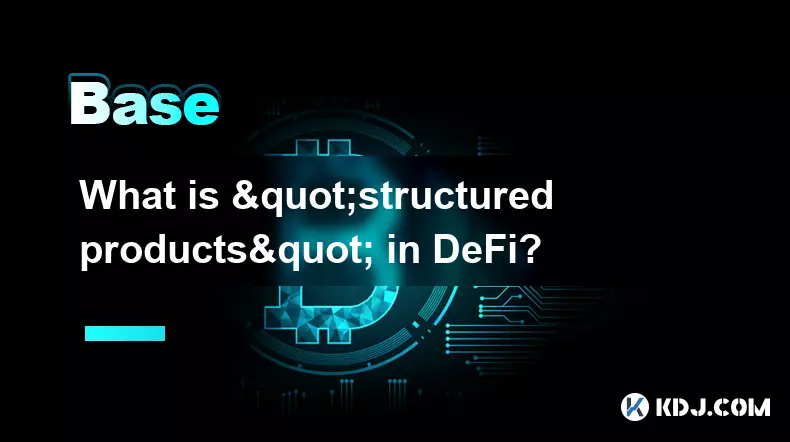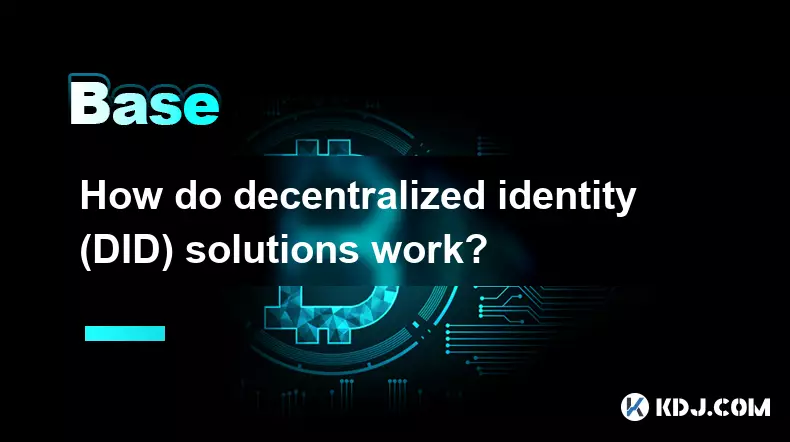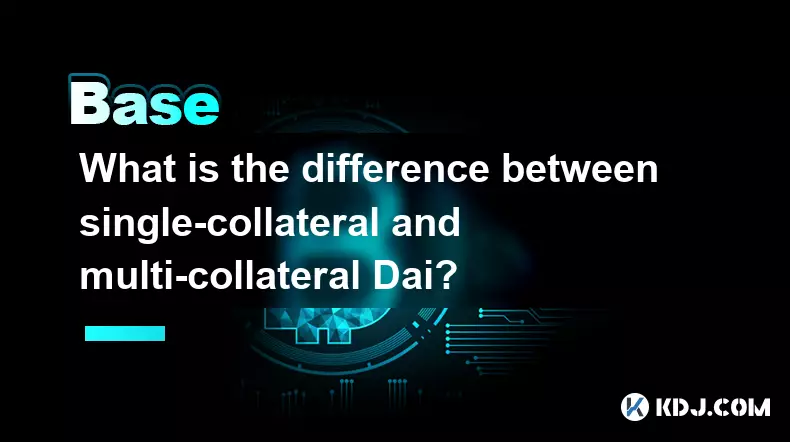-
 bitcoin
bitcoin $106975.071866 USD
-0.29% -
 ethereum
ethereum $3871.670850 USD
-0.07% -
 tether
tether $1.000261 USD
-0.01% -
 bnb
bnb $1084.417621 USD
-0.50% -
 xrp
xrp $2.348167 USD
0.82% -
 solana
solana $185.621736 USD
0.45% -
 usd-coin
usd-coin $0.999833 USD
-0.04% -
 tron
tron $0.313423 USD
0.81% -
 dogecoin
dogecoin $0.188856 USD
0.54% -
 cardano
cardano $0.630416 USD
-0.49% -
 hyperliquid
hyperliquid $36.506353 USD
2.24% -
 ethena-usde
ethena-usde $0.999584 USD
-0.01% -
 chainlink
chainlink $16.750026 USD
-0.77% -
 stellar
stellar $0.313373 USD
0.37% -
 bitcoin-cash
bitcoin-cash $465.978560 USD
-1.57%
What is "structured products" in DeFi?
DeFi structured products combine crypto assets with derivatives via smart contracts to create yield-enhancing, risk-tiered strategies like covered calls and tokenized yields.
Sep 02, 2025 at 11:01 pm

Understanding Structured Products in DeFi
1. In decentralized finance (DeFi), structured products refer to customized financial instruments that combine basic crypto assets with derivatives to achieve specific risk-return profiles. These products are typically built using smart contracts on blockchain networks, allowing for automated execution and transparency. Unlike traditional finance, where such products are offered by banks or investment firms, DeFi enables permissionless access to these instruments through decentralized protocols.
2. The core idea behind DeFi structured products is to offer yield-enhancing strategies that go beyond simple lending or staking. For example, a structured product might involve selling covered call options on a deposited asset to generate premium income. This allows users to earn additional returns during sideways or slightly bullish market conditions, even if they don’t actively trade.
3. These products often integrate stablecoins, volatile tokens like ETH or BTC, and derivative positions such as options or futures. By combining them algorithmically, protocols can create tranches with different risk levels—similar to how collateralized debt obligations (CDOs) were structured in traditional markets, though with greater transparency and programmability.
4. One of the most common types of structured products in DeFi is the 'yield tokenization' model, where future yield streams are tokenized and sold to investors. For instance, a user might deposit ETH into a vault that automatically sells out-of-the-money call options weekly. The yield from the option premiums is distributed to participants, offering a predictable income stream backed by on-chain activity.
5. Because these products are governed by code, they reduce reliance on intermediaries. However, they also introduce smart contract risk, oracle dependencies, and potential impermanent loss in certain configurations. Users must carefully assess the underlying mechanisms and historical performance before participating.
Key Components of DeFi Structured Products
1. Smart contracts serve as the foundation, automating the logic behind asset allocation, derivative execution, and payout distribution. These contracts are typically open-source, allowing independent audits and real-time monitoring of fund flows.
2. Oracles provide external price data necessary for triggering option exercises, rebalancing events, or liquidations. Reliable price feeds from networks like Chainlink are critical to ensure fair and accurate execution.
3. Liquidity pools enable the aggregation of user funds into larger vaults, which can then be deployed into strategies like covered calls, put selling, or range accruals. Pool-based designs allow retail investors to access institutional-grade strategies with minimal capital.
4. Risk segmentation is often achieved through senior and junior tranches. Junior tranches absorb initial losses but earn higher yields, while senior tranches receive priority in payouts but with capped returns. This structure mirrors traditional credit enhancements but operates transparently on-chain.
5. Governance tokens may be used to decentralize control over parameter adjustments, strategy selection, or fee structures. Some protocols allow token holders to vote on new product launches or risk thresholds, fostering community-driven development.
Popular Examples and Use Cases
1. Ribbon Finance offers structured vaults where users deposit assets like ETH or WBTC and earn yield by automatically selling covered calls or puts. The protocol executes these options weekly via auctions on Deribit or through on-chain options like Lyra, distributing premiums to depositors.
2. Hegic enables users to create flexible options positions by locking collateral and setting strike prices and durations. While not a vault itself, it serves as an infrastructure layer for structured products that require customizable derivatives exposure.
3. BarnBridge pioneered tokenized risk tranching with its SMART Yield product, which splits bond-like crypto yields into senior and junior bonds. Senior bondholders get stable returns, while junior bondholders take on volatility for higher upside.
4. Dopex operates a decentralized options exchange with a focus on structured vaults. Its 'Range-accrual vaults' pay users to hold assets within a specified price range, rewarding stability with enhanced yields.
5. Premia Finance allows users to sell options and earn premiums while offering buyers the ability to hedge their positions. Its AMM-based model adjusts pricing dynamically based on volatility and demand, making it suitable for automated yield strategies.
Frequently Asked Questions
What risks are associated with DeFi structured products?Smart contract vulnerabilities, oracle manipulation, and market volatility are primary concerns. If the underlying protocol has a bug or is exploited, users can lose principal. Sudden price swings may trigger unfavorable derivative payouts, especially in leveraged or short option positions.
How do structured products generate higher yields than standard lending?They incorporate active strategies like option writing, which collects premiums. These premiums are additional income streams beyond interest from lending, effectively monetizing price stability or moderate appreciation of the underlying asset.
Are structured products suitable for beginner investors?They require a solid understanding of derivatives, risk layers, and protocol mechanics. Beginners may face steep learning curves and should start with low capital exposure or opt for senior tranches with lower risk profiles.
Can structured products be used for hedging?Yes. Some structured products are designed to provide downside protection by embedding put options or dynamic rebalancing. Investors holding volatile assets can use these instruments to reduce exposure during turbulent markets while still earning yield.
Disclaimer:info@kdj.com
The information provided is not trading advice. kdj.com does not assume any responsibility for any investments made based on the information provided in this article. Cryptocurrencies are highly volatile and it is highly recommended that you invest with caution after thorough research!
If you believe that the content used on this website infringes your copyright, please contact us immediately (info@kdj.com) and we will delete it promptly.
- OpenSea's SEA Token: A Bold Buyback Program Signals a New Era
- 2025-10-19 14:25:16
- Pi Coin's App Studio Upgrade: AI, Staking, and Utility Expansion
- 2025-10-19 14:25:16
- Bitcoin at $100K? Or Doomed? A New York Minute on Crypto's Wild Ride
- 2025-10-19 14:45:11
- XRP, Treasury Plan, and ETF Uncertainty: A Deep Dive
- 2025-10-19 14:45:11
- Crypto Trading Decoded: Technical Analysis, Regulation Influence, and Navigating the Tides
- 2025-10-19 14:30:16
- Pi Network's Global Visibility: Pinned to the Top in the Cryptocurrency World
- 2025-10-19 14:30:16
Related knowledge

How do decentralized identity (DID) solutions work?
Oct 14,2025 at 11:36pm
Understanding Decentralized Identity in the Blockchain Ecosystem1. Decentralized identity (DID) solutions are built on blockchain networks, allowing i...

What is the difference between Near Protocol and Ethereum?
Oct 15,2025 at 08:01am
Near Protocol and Ethereum: Core Architectural Differences1. Near Protocol operates on a sharded blockchain architecture known as Nightshade, which al...

What does it mean for code to be "open source" in crypto?
Oct 12,2025 at 01:54pm
Understanding Open Source in the Cryptocurrency Ecosystem1. In the context of cryptocurrency, open source refers to software whose code is publicly ac...

What is the purpose of a "testnet"?
Oct 12,2025 at 09:01am
Understanding the Role of Testnets in Blockchain Development1. A testnet serves as a parallel version of a blockchain network, designed specifically f...

How to avoid phishing scams in crypto?
Oct 13,2025 at 06:18pm
Understanding Common Crypto Phishing Tactics1. Cybercriminals frequently use fake websites that mirror legitimate crypto exchanges or wallet platforms...

What is the difference between single-collateral and multi-collateral Dai?
Oct 12,2025 at 05:18pm
Understanding Single-Collateral Dai1. Single-Collateral Dai (SCD) was the original version of the Dai stablecoin launched by MakerDAO in 2017. It allo...

How do decentralized identity (DID) solutions work?
Oct 14,2025 at 11:36pm
Understanding Decentralized Identity in the Blockchain Ecosystem1. Decentralized identity (DID) solutions are built on blockchain networks, allowing i...

What is the difference between Near Protocol and Ethereum?
Oct 15,2025 at 08:01am
Near Protocol and Ethereum: Core Architectural Differences1. Near Protocol operates on a sharded blockchain architecture known as Nightshade, which al...

What does it mean for code to be "open source" in crypto?
Oct 12,2025 at 01:54pm
Understanding Open Source in the Cryptocurrency Ecosystem1. In the context of cryptocurrency, open source refers to software whose code is publicly ac...

What is the purpose of a "testnet"?
Oct 12,2025 at 09:01am
Understanding the Role of Testnets in Blockchain Development1. A testnet serves as a parallel version of a blockchain network, designed specifically f...

How to avoid phishing scams in crypto?
Oct 13,2025 at 06:18pm
Understanding Common Crypto Phishing Tactics1. Cybercriminals frequently use fake websites that mirror legitimate crypto exchanges or wallet platforms...

What is the difference between single-collateral and multi-collateral Dai?
Oct 12,2025 at 05:18pm
Understanding Single-Collateral Dai1. Single-Collateral Dai (SCD) was the original version of the Dai stablecoin launched by MakerDAO in 2017. It allo...
See all articles





















![[4K 60fps] Astral by oc3andark (1 Coin) [4K 60fps] Astral by oc3andark (1 Coin)](/uploads/2025/10/19/cryptocurrencies-news/videos/k-fps-astral-ocandark-coin/68f438453fa33_image_500_375.webp)




















































